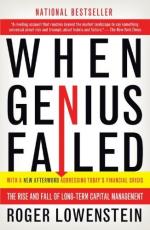
|
| Name: _________________________ | Period: ___________________ |
This test consists of 15 multiple choice questions and 5 short answer questions.
Multiple Choice Questions
1. What word did people often use to describe Long-Term?
(a) Communist.
(b) Dangerous.
(c) Stupid.
(d) Genius.
2. When Russia began to default on its loans, what did people start doing with their high risk bonds?
(a) Trading.
(b) Holding.
(c) Buying.
(d) Selling.
3. Once the financial market in Russia collapsed, what did people stop trading?
(a) Stocks.
(b) Corn.
(c) Commodities.
(d) Bonds.
4. After the meeting with the Fed, a market movement of what percentage could have ended Long-Term?
(a) 1%.
(b) 10%.
(c) 25%.
(d) 30%.
5. In August 1998, how far down was Long-Term for the month?
(a) 25%.
(b) 44%.
(c) 60%.
(d) 10%.
6. By the end of August 1998, what market had practically stopped trading altogether?
(a) Bond markets.
(b) International markets.
(c) Gold markets.
(d) Stock markets.
7. In a letter to clients, to what did Long-Term attribute the decrease in profits?
(a) Foolish investments.
(b) Irresponsibility in foreign nations.
(c) Widening spreads.
(d) Poor margins.
8. In 1998, what were many hedge funds selling insurance against?
(a) Falling prices.
(b) Rising prices.
(c) The U.S. Treasury.
(d) The Latin market.
9. What did Long-Term think about the financial crisis that hit in August of 1998?
(a) It was serious and would not recover.
(b) It was not serious but would not recover.
(c) It was not serious.
(d) It was serious but would recover.
10. What did Scholes and Merton think of some of the private trades Long-Term made in 1998?
(a) They did not support them.
(b) They were excited.
(c) They supported them.
(d) They were impressed.
11. After the Russian financial crisis, what caused further fluctuations in the market?
(a) Panicked investors.
(b) Interest from the IRS.
(c) Small time investors.
(d) Interest from big oil.
12. In August 1998, how far down was Long-Term for the year-to-date?
(a) 52%.
(b) 2%.
(c) 35%.
(d) 10%.
13. The purpose of the Federal Reserve System was to promote what?
(a) Stability.
(b) Honest investments.
(c) Morality.
(d) Local investments.
14. In 1998, who published Meriwether's letter to his clients?
(a) The Financial Times.
(b) The New Yorker.
(c) The New York Times.
(d) Bloomberg.
15. What trading date dropped Long-Term below $1 billion in equity?
(a) September 5.
(b) October 10.
(c) September 21.
(d) April 15.
Short Answer Questions
1. What notable player was on vacation during the crisis in Russia?
2. During the financial crisis in 1998, what did the partners keep from the workers?
3. What did the Fed Chairman want to remove in an effort to create liquidity in the market?
4. How much money did Chase loan Long-Term so that they could continue to clear trades?
5. In 1998, Long-Term expected prices to do what?
|
This section contains 391 words (approx. 2 pages at 300 words per page) |

|




